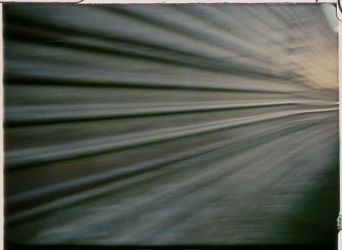Robert Fenz, Stills from Crossings, 2006-07.
Born 1969 in Ann Arbor, Michigan; lives in Cambridge, Massachusetts
While Robert Fenz’s 16-millimeter films document place and time, they also serve as emotive simulacra reminding the viewer of cinema’s historical subjectivity. Editing together footage of daily life from countries in political upheaval, he illustrates human characteristics that transcend borders in semihypnotic odes to the lands he portrays. Fenz’s self-proclaimed “moving pictures”—silent or presented with recorded natural sound—offer glimpses into cultural diversity while experimenting with in-camera editing and a variety of formal cinematic techniques. Inspired by Structuralist filmmakers such as Michael Snow and James Benning, Fenz sometimes builds his films along predetermined guidelines. His methods, however, are improvised and lyrical, closer to the work of Chantal Akerman, with whom he has recently worked. “My need to think or feel something through film,” he notes, “is not reactionary against video, but a concern for film’s disappearance as a material.”
Fenz traveled to Brazil, Cuba, Mexico, and around the United States to capture footage of the poverty and political strife that precede and encourage revolution for his five-part series Meditations on Revolution, each segment offering a new set of experimental platforms. For the 2002 Whitney Biennial, Fenz screened Part III: Soledad (2001), a black-and-white silent film alternating footage of masked insurgents in Chiapas with urban scenes and sequences of two men making tortillas in Mexico City. In Part V: Foreign City (2003), a blackand- white film with sound about immigrant New York, Fenz pushes the grain quality to “accelerate the randomness of the film,” distinguishing it from video as a medium able to, as he describes, “vibrate.” The artist’s overarching formal concern in Meditations centers on black-and-white film’s capacity to trigger memory by referring to previously recorded events as well as the history of cinema.
In Crossings (2006–07), made for the 2008 Whitney Biennial, Fenz switches to color film to convey more sensate information about the United States–Mexico border wall. Ten minutes of film features Crossings played twice—first silently, next with ambient sound—allowing the viewer to imagine a soundtrack before the imposed audio begins. Presented as quick, single-frame snapshots are a pair of frames shot looking to the left and right from each side of the wall followed by upward and downward views on both sides, creating a strobelike effect that recalls the psychedelic experiments of James Whitney or Harry Smith. The length of each shot is of primary importance to Fenz, for whom each frame is a captured moment in time. These moments build, highlighting the surprising formal beauty of the wall while evoking the frenetic, fearful energy one might feel if trapped by it. By visually simulating what the wall symbolizes, Fenz depicts terror and awe as impossibly intertwined. TRINIE DALTON
Robert Fenz, Stills from Crossings, 2006-07. 16mm film, color, sound and silent; 10 min. Collection of the artist.
























